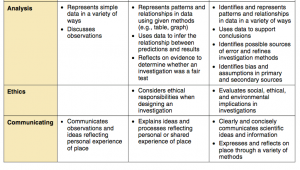Rubric
Providing a list of requirements for a project as well as a rubric can help provide guidance and clarity, while still allowing freedom to create. Teachers can use a rubric to mark the product at the end (summative, assessment of learning) and students can self-check throughout the creation of their project (formative, assessment as learning).
Grade: intermediate 5-7
For, of, as: of and as, depending on whether the student is using the rubric to direct planning, or the teacher to mark the product.
Summative or Formative? Both, depending on when it is used.
Strengths:
Students can check as frequently as they want to see if they are meeting requirements.
Students can use the rubric to ‘break down’ portions of their project into manageable parts.
A detailed rubric provides a simple way to assess a product and transfer assessment into numerical data.
Weaknesses:
Some students may be confused by the layout of rubrics.
Students may exceed in some ways not accounted for on the rubric, but miss other areas- human judgement is still necessary.
Source: http://pfjpaperrmv.web.fc2.com/essay/page-2716.html
Sample:

